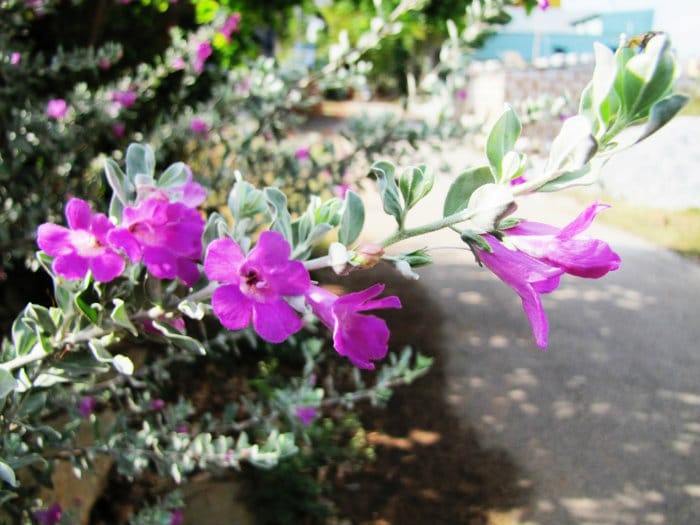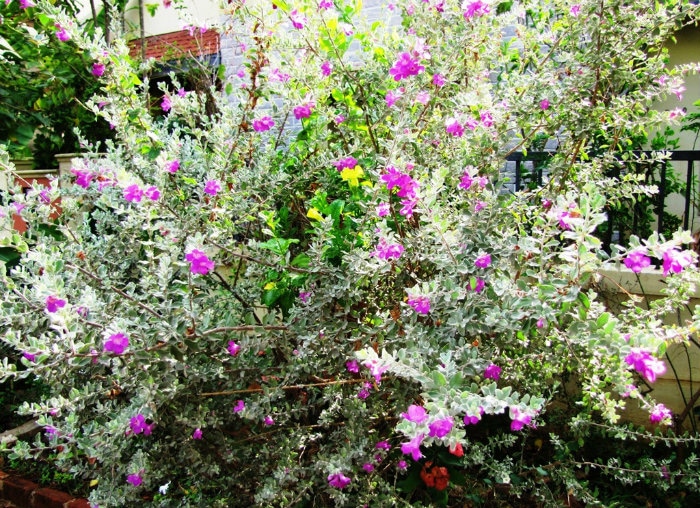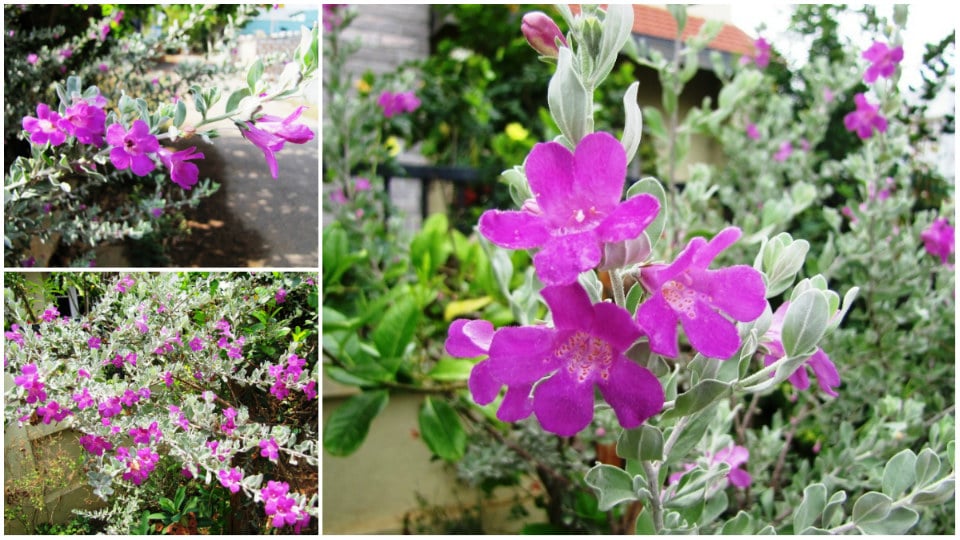Text & photographs by Dr. Mahadeswara Swamy, Scientist
Mob: 97429-91057 e-mail: [email protected]
Texas Sage is a landscape wonder that provides stunning display of prolific purple blooms. This decorative ornamental shrub with delicate silvery gray-green leaves is quite distinct from the common sage. The plant is drought-tolerant and thrives in poor soil where other plants fail. A classic in the American Southwest Texas, the plant bursts into bloom after showers on and off from spring. Each time it flowers, the charming blooms stay for a week or two.
It is also called “Barometer shrub” as it blooms after rains. The plant has other names like Texas Ranger, Texas rain sage, Cenizo, Texas silver leaf, Texas barometer bush, Ash-bush, Wild lilac, Purple sage, Senisa, Cenicilla, Palo Cenizo or Hierba del cenizo. The scientific name is Leucophyllum frutescens belonging to the figwort family, Scrophulariaceae. The genus name Leucophyllum means ‘with white leaves’ and species name frutescens ‘shrubby or becoming shrubby.’ The shrub is native to South western USA (Texas) and Northern Mexico (States of Coahuila, Nuevo León and Tamaulipas ).
Leucophyllum frutescens is an evergreen compact shrub which grows up to 6 feet in height with almost equal spread (width). Occasionally, the plant may be deciduous. The leaves are densely covered with stellate, silvery hairs and soft to touch. They are silvery gray to greenish, tapering gradually to the base than to the rounded tip, with smooth margins; up to 11/4 inches long. They resemble the leaves of maruga (kannada). The new wood on the plant produces copious blooms. Flowers are borne singly in crowded leaf axils and bilaterally symmetrical. They are more or less bell-shaped with five lobes and two lips with bright pink-lavender colour. To be more precise, each flower has three fuzzy petals and a fused set below with conspicuous white anthers. Fruit is a small capsule. However, I have not observed these plants producing fruits in Mysuru.
There are few varieties/cultivars like ‘Green Cloud’, ‘White Cloud’, ‘Compacta’, ‘Convent’, and ‘Bert-Star’ with varying colours of Pink, Purple, Silver.

Useful Tips
- It is a versatile plant useful for landscaping as hedge, accent plant, privacy screen, specimen shrub for the corner of the house or lawn, backdrop for smaller plants, for lining walkway or drive, along the fence, surrounding tall palms.
- It can also be grown in large containers.
- Suitable for big gardens and parks.
- It needs full sun, warmer areas, minimal watering and very little care and maintenance.
- It is not a nutrient hog and needs well-drained soil. Alkaline soil is preferable, but not a must.
- It rots easily if stagnated. Yellowing of leaves is an indication of water stagnation. Hence, plant it a little on the high side so that water does not stagnate.
- Once the plant matures it may grow scraggly. Hard prune by cutting the branches at alternate lengths instead of trimming the whole bush.
- Because of its drought- tolerance, Texas sage is often used in xeri-scaping.
- This is one plant where too much care — water, fertiliser, trimming — can actually be detrimental to its health. Hence, this hardy shrub, in my view, is a good candidate for road dividers (median) on highways as substitutes for Bougenvilleas and other plants.
- The flowers attract bees, butterflies and other pollinators. Surprisingly, deer and rabbits do not come near the plant.
Propagation
It is easy to propagate from stem cuttings. Take 4-inch softwood cuttings after blooming ends in summer or hardwood cuttings when the plant is dormant in late fall or winter. Plant the cuttings in a well-drained potting mix (sand + leaf mould in equal proportion). Even the well-drained sandy soil is sufficient. Dipping the bottom of the cuttings in rooting hormone will stimulate root initiation and quicker propagation. Keep the potting soil moist until roots develop, which takes 3 or 4 weeks. Transplant the propagated cuttings when fresh leaves start growing. Once the plant is established, it will need supplemental water only during extended dry periods.

Where to see
Private gardens and parks more specifically in the MUDA park opposite Kaveri Grameena Bank (near Nirmithi Kendra) in Vijayanagar 3rd Stage. Look out for the fresh bout of flowers after the next spell of rains.
P.S.: Texas Sage is not intended for human or animal consumption and should not be confused with the common sage (Salvia officinalis) used for culinary use.








Recent Comments